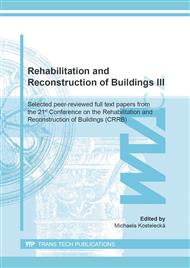p.51
p.57
p.65
p.70
p.79
p.86
p.92
p.98
p.105
Design and Comparison of the Different Material Compositions of the External Masonry Construction of the Building
Abstract:
In Slovakia, since August 2016, a change in the thermal standard STN 73 0540-2 [6] has been in force, taking into account the objective of the European Directive, which since 2021 counts on the construction of buildings with almost zero energy consumption. One of the objectives of these changes is to reduce energy consumption in buildings min. by 20% till 2020. In this article it is compared the selected structures of the support exterior walls with regard to the criterion of the required thermo-technical characteristics of the building structure - coefficient of heat transfer of the structure U for the ultra-energy building according to STN 73 0540 part 2 from 2016 [3, 6]. Finally, the most cost-effective structure that meets the required thermal and technical parameters was the masonry structure with an additional by insulating the ETICS (with meaning External Thermal Insulation Composite System).
Info:
Periodical:
Pages:
79-85
Citation:
Online since:
October 2020
Keywords:
Price:
Сopyright:
© 2020 Trans Tech Publications Ltd. All Rights Reserved
Share:
Citation:


